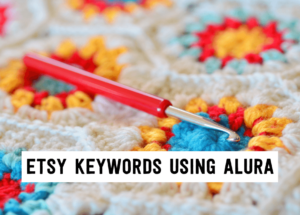
How to find the best Etsy keywords in 3 simple steps using Alura
If you want to be found in search results on Etsy, you need to optimize your product listing for SEO. And if you want to
join
Hmmm….Etsy Listing Quality Score?
Maybe you’ve heard of it but you’re not so sure what it is or what on earth you should do about it . . .
OR you might actually be scratching your head and thinking… Etsy listing what?
In any case – don’t fret, I shall explain!
And . . . what if I told you that it’s the MOST important thing you can work on to help your products rank high in search results on Etsy (yes, really!) and to boost your sales? Double win! Curious?
Good! Because today I’ve got 9 tips sure to help you get your score (and SALES!) up!
Ready? Let’s dive in!
Now the Etsy listing quality score is only 1 of many ranking criteria on etsy. If you’re wondering what the other ranking criteria are, I actually have an article that covers all of the Etsy ranking criteria and how the Etsy algorithm works which you can read after this one.
But for today, let’s get into the nitty-gritty of what the listing quality score is and how to use it to boost your sales
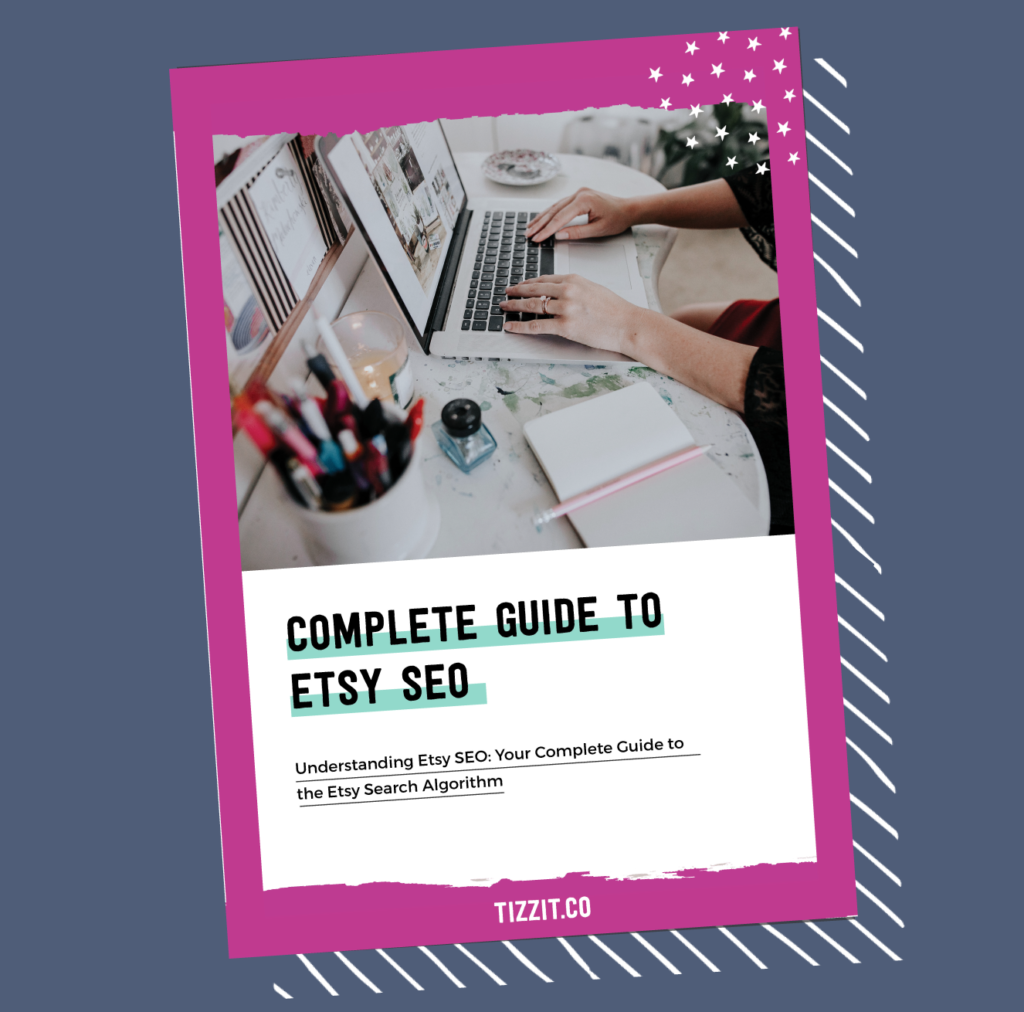
Grab this free ETSY SEO GUIDE!
a complete guide to Understanding how etsy search (and ranking) actually works so you can make the most of it and get more views on your products.
If you look in the Etsy seller handbook, you will see this official definition of the listing quality score:
“When a buyer searches on Etsy, our goal is to help them find items they want to purchase. To do this, Etsy search looks at clues from shoppers to determine whether a listing is appealing and meets their expectations once they click. We look at how well a listing converts—how many people view it and then make a purchase—to determine whether buyers are interested in it, which boosts that listing’s quality score and placement in search results.”
They also state that “to determine a listing’s quality score, we factor in a combination of data such as clicks, views, favorites, and purchases. The higher the quality score the higher the item may appear in search results.“
So essentially, Etsy is looking at how people interact with your listing and if they end up purchasing your product.
If they don’t, Etsy isn’t going to rank your products very high in search results because it’s basically a waste of real estate.
If a listing isn’t converting into sales, it not only won’t lead to a good result for you, but it’s also not going to lead to a positive result for Etsy as a business (because remember they make money when you make money). So Etsy will place listings that are more likely to turn into sales higher in the search results because that’s how their business works, that’s how they make money.
At this point you may wonder… how do I know what MY listing quality score is? Where is this information? And it’s a GREAT question but sadly the answer is … you don’t. They don’t tell you what your score is, they just calculate it as part of the search algorithm. The best way to know how you’re doing though is to calculate your listing conversion rate … because it’s the closest thing to it that you can actually calculate and track.
Now keep reading this article because there’s a lot more I need to share with you about Etsy’s listing quality score . . . but if you don’t know what your conversion rate is or even how to calculate it I have an article that will help you learn all about your Etsy conversion rate and how to improve it.
OK – now that you know what the listing quality score is, let’s talk about why it’s such an important part of the ranking criteria and how it works to boost your sales AND your search ranking.
A good listing quality score will help you on two fronts.
First, it helps you get sales – because when your listing quality score is higher, then by definition you’re getting more sales out of the views your listing is getting.
And because you’re getting more sales, you start to rank higher in search results . . . which means that you’re going to start getting even more sales because you’ll get more views. . . and in essence it has created what I call a “happy loop,” or more officially, a virtuous cycle.
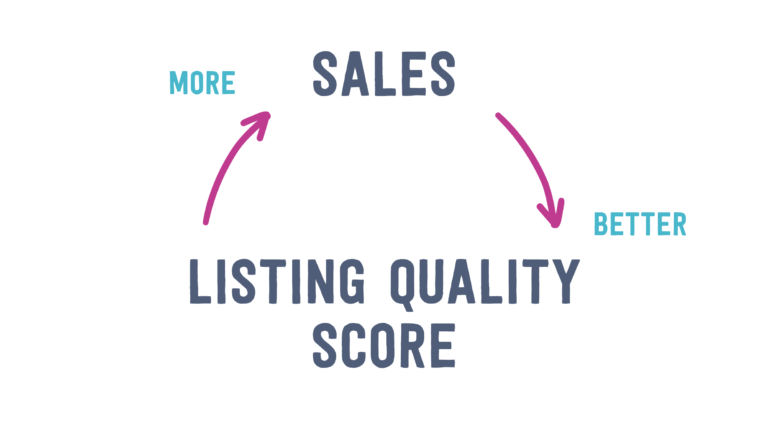
In my opinion, your listing quality score will be the most important factor for SEO. I have an article called Etsy Keywords Are Not Enough where I dive a bit more into this but in a nutshell, I think that there are too many people obsessing over keywords when it comes to SEO.
Of course they’re very important, and I talk about them quite a bit. But if I had to choose, I would concentrate on the listing quality score. Because even with the absolute best keywords in the world, if you don’t have a good listing quality score you’re not going to get any sales and therefore you’re not going to get ranked in search — if your listing quality score is low Etsy will think that your products are not selling and at that point … even the best keywords in the world won’t get you high in search results and so you won’t be making sales.
You don’t want to fall into the trap of thinking “as long as I have a good keyword strategy, I’ll be seen in search results and I’ll get views.” The truth is, good keywords only help you initially, while Etsy gets an idea of your listing quality score. I’m simplifying the process a bit here but typically, if 2 listings in 2 different shops have the same exact keywords but one has a higher listing quality score — then Etsy is going to start showing that listing more.
Speaking of competing by getting a good listing quality score . . . how are you going to do that?
To increase your listing quality score, there are 6 key points that you really need to nail down at the listing level, plus 3 more that are not necessarily specific to the individual listing but are just generally important in your Etsy strategy and will impact your listing quality score.
Let’s start with details that are key at the listing level.
The very first thing you want to pay attention to is the first photo because it gets you the click in search results. If your first photo isn’t good, no one’s going to click on it, and no one’s going to see your other photos. On top of that, “Clicks” are also part of how Etsy calculates your listing quality score. So that main thumbnail image is really, really important.
Spend some time doing searches for your product and notice what photos are like for similar listings that are ranking high in search results. You can also experiment with different things here: for some of you a plain background is going to work really well, for others it’s going to be a shot with a model, for others it’s going to be a styled shot. It depends on the niche and what you sell, but you need to be testing this to find which photo is bringing you the most views.
Once you have a good first photo, the rest of your photos are obviously very important as well. In fact they are THE most important thing for you to get right to get people to buy. It’s not just having beautifully lit, professional looking photos (that’s the bare minimum) – it’s more so about the information your photos give to potential customers and deciding what your photos should show and tell them about your product because the majority of people won’t read your product description. 90% of the purchase decision is made based on the photos only.
I have another article where I share my best Etsy listing photo tips – so make sure you check it out after you finish this one, it’s well worth the read!
Next thing to look into are your product descriptions. As I just mentioned, your product descriptions won’t be the first thing someone looks at but if your photos are 90% of the purchase decision, your product descriptions are the remaining 10% – and are what will get people over the line and adding to cart. That’s why it’s also very important to write a good product description that can actually help you make more sales.
If you want more help here – I have another article about writing product descriptions that sell where I dive into the details.
The next thing you want to be mindful of is processing times. When it comes to processing times, it’s not about shipping as quickly as you can, I mean, obviously, to an extent, yes.
But also, you’re not Amazon, and you shouldn’t be expected to be able to pack and ship the next day. So it’s more about making sure that you’re competitive. And so what you want to check is the average processing time for the type of keywords and the products that you’re selling.
To do this, I use a tool on Erank that helps me see the average processing time shops require to prepare and ship an order in a specific niche. You can see in this screenshot that in this product niche, 22% of the listings have a processing time of 5-10 days, and the majority of shops have a processing time shorter than 10 days, so that is what you would want to stay within.
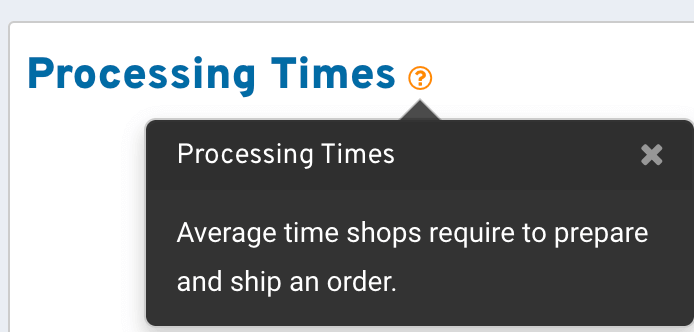
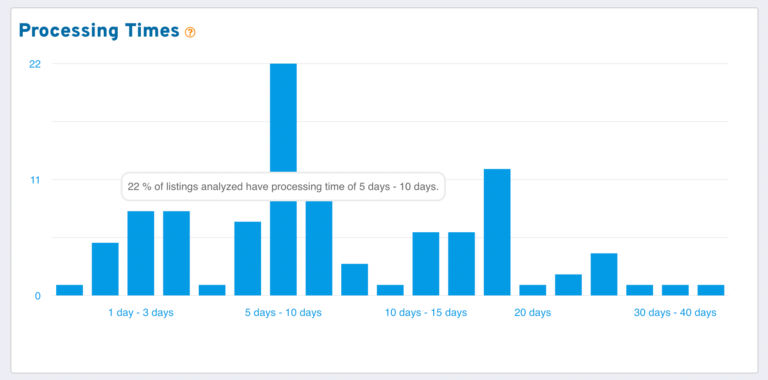
The next thing we need to talk about is shipping.
Now I know that there is a big emphasis on Etsy to offer free shipping, or as low as possible shipping, as much as possible to help boost sales – and if that’s something that you can offer, then definitely consider it. But the fact is that it’s not always going to be possible, and it’s also not really possible for some niches where you sell really heavy, difficult to ship items.
And so here again, I would see what’s happening generally in the niche that you’re in and the products that you’re selling, and Marmalead has a handy data tool for this.
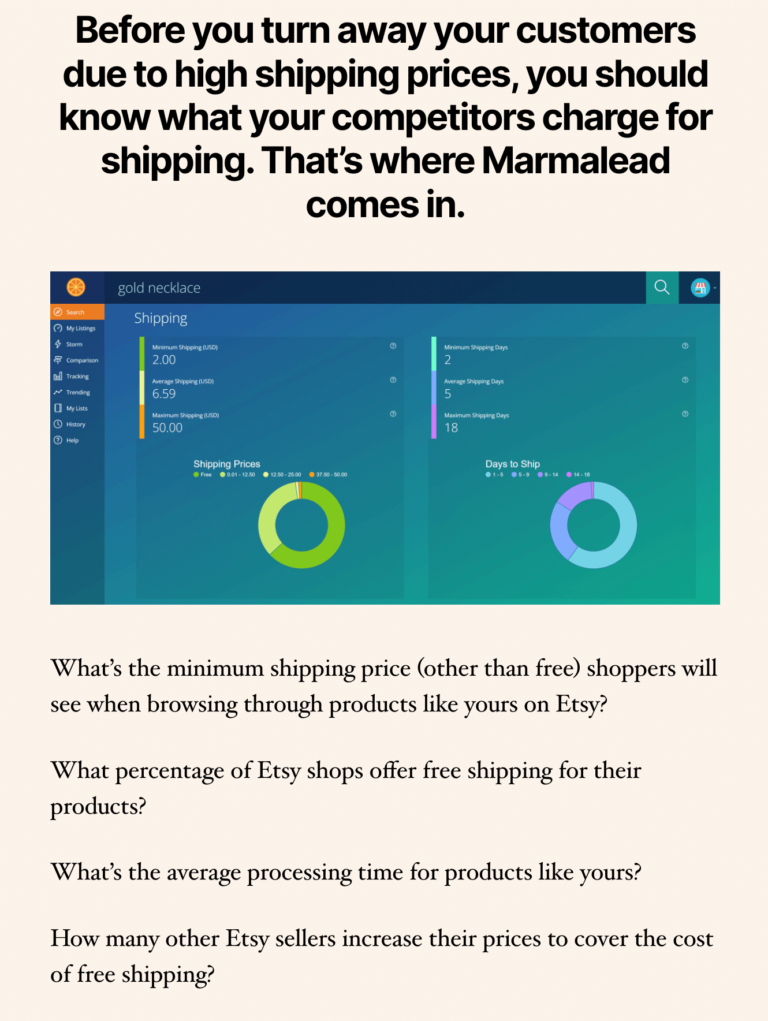
Similar to the Erank tool, you can search for the keyword that you know describes your product the best, and then have a look at the percentage of shops that offer free shipping, the minimum shipping price shoppers can find, and what the average shipping seems to be . . . and see where you sit in comparison.
You also want to be very mindful and strategic when setting up your listing structure, including how you list your variations (you know… those options inside a listing that shoppers see as drop down).
I have two articles that talk about this in GREAT detail, but what I want you to remember today is that you don’t want to give your customer too many options AND sometimes you’re much better off splitting your variations into different listings. I’ll put the links to those articles below for you to check out.
Last but not least and “the elephant in the room” – pricing. Obviously, your price is going to have an impact on whether someone wants to purchase your product or not because that’s what they have to pay to get it.
I was hesitant to even include this point in this article because the last thing that I want to do is encourage you guys to compete on price – this is something that I’m strongly against! And I never ever want you to price your product only based on what other people are pricing theirs at, mostly because that’s never a good strategy — price is the last thing you want to be competing on.
On Etsy, in particular, there are a lot of sellers who do not price for profit, either because they’re happy to just cover their expenses because they consider their craft a hobby and they don’t really want to make money from it, or because they don’t know how to and haven’t learned about pricing properly for profit and profit margins.
And so there are a lot of sellers that are underpriced on the platform, and if you try to compete with someone that’s underpriced you are never going to make money.
It’s a race to the bottom.
So when we talk about pricing, it is so that you can check in general where your price is at in the marketplace and how you compare to other sellers.
You never want to reduce your price just to be competitive because that could result in not having a profit margin to actually run your business. You want the price to be competitive, but only within the limits of what you can afford.
There is an Erank tool for this, similar to the processing times tool, where you can type in the very specific keyword for your product and see what prices are most common.
I have one tip for you when you use this tool:
Just like with the processing times tool we talked about earlier, you want to go in with a very specific keyword. Because if you type in something like “gold ring”, for example, it’s likely too broad of a keyword.
You don’t know what type of gold ring it is, how thin or chunky it is, if it’s yellow gold or white gold, 14 Karats or 24 Karats, if it has a diamond or other stone or doesn’t . . . all of these details are going to affect the price a fair bit and so you can’t really compare when you have a broad keyword like that. So it’s better to use this tool with a very specific long tail keyword to give you an idea of the price range for the specific product that you’re selling.
All of these listing-specific details are very important and affect your listing quality score as they affect how likely people are to purchase your products, but in addition there are three more general areas you need to pay attention to.
The first of these is your reviews.
Potential buyers look at reviews, so good reviews for your store and your products will help with sales.
Getting good reviews means focusing on good customer service and lovely packaging, encouraging people to leave a review, ensuring there are no “bad surprises” when someone receives their product (caused by a photo not representing the item well for example, or by overpromising on delivery times, etc.) — just all the things that make customers happy and will translate to positive reviews.
You also want to look at the “bigger picture” that your shop presents to each potential customer: Is your shop well branded? Are your products cohesive? Are you focusing on a specific niche or are you all over the place with who you are selling to and what you are selling?
Remember, first impressions matter . . . A LOT! And you only get one shot at making a good one.
Increasing your Listing Quality Score is not just about looking at each individual listing — how your brand and shop present as a whole will influence potential customer decisions.
Finally, you want to help people find products easier with well-thought-out and optimized shop sections.
Shop sections can make a big difference between a shopper staying in your shop – and browsing through multiple product listings – or clicking off your shop and into another seller’s after the first listing – which is not going to help your sales.
A well-thought-out shop structure makes sure each visitor has a good shopping experience and can easily navigate and find what they are looking for.
I have an article about how to organize your Etsy shop sections that can help you do that!
If you liked these tips and would like to hear about even MORE ways to boost your sales, check out my Youtube channel which is full of helpful videos!
Thanks for reading, and until next time, aurevoir!
you might also like…
related articles

If you want to be found in search results on Etsy, you need to optimize your product listing for SEO. And if you want to
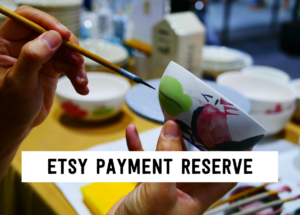
There has been a lot of talk in the Etsy community — and I mean A LOT of talk — about Etsy’s payment account reserve
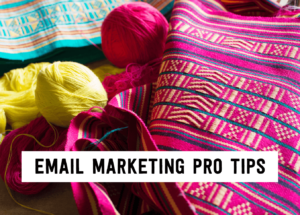
Anyone who knows me knows that I am a HUGE advocate for using email marketing to grow and scale your handmade business. But you may
Sign up below and get instant access to a collection of FREE practical guides, workbooks, and checklists that will help you start, grow and profit from your handmade shop. (without pulling your hair out!).
disclaimer
subscribe to youtube
become a member
get in touch
We acknowledge and give thanks to the Budawang and Yuin people, the Traditional Owners of the land we work and live on. We pay our respects to all Aboriginal and Torres Strait Islander Peoples and elders past, present and emerging.
4-step Maker’s Roadmap System
Library of In-Depth Courses and Training
Live Monthly Coaching Sessions
A Supportive Online Community
close
We hate spam too. Unsubscribe at any time.
close
We hate spam too. Unsubscribe at any time.
close
We hate spam too. Unsubscribe at any time.
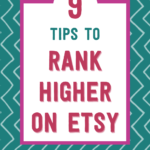


Get Instant Access to this
complete etsy seo guide